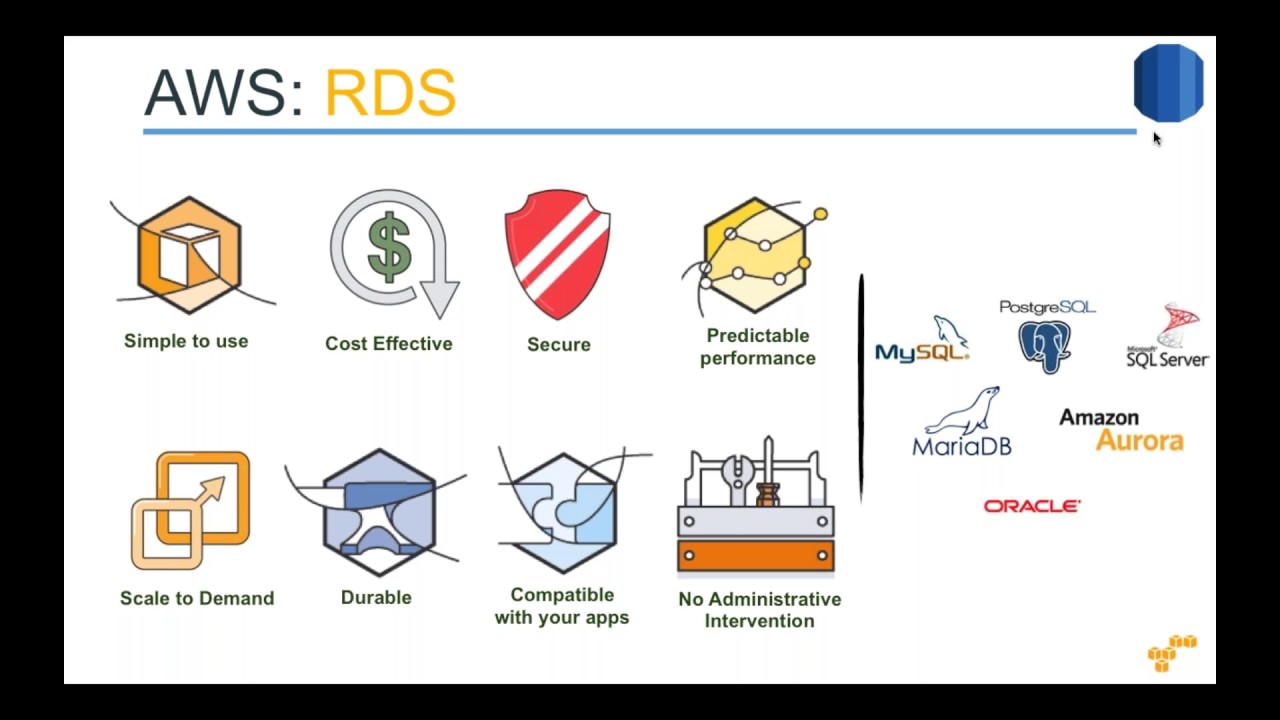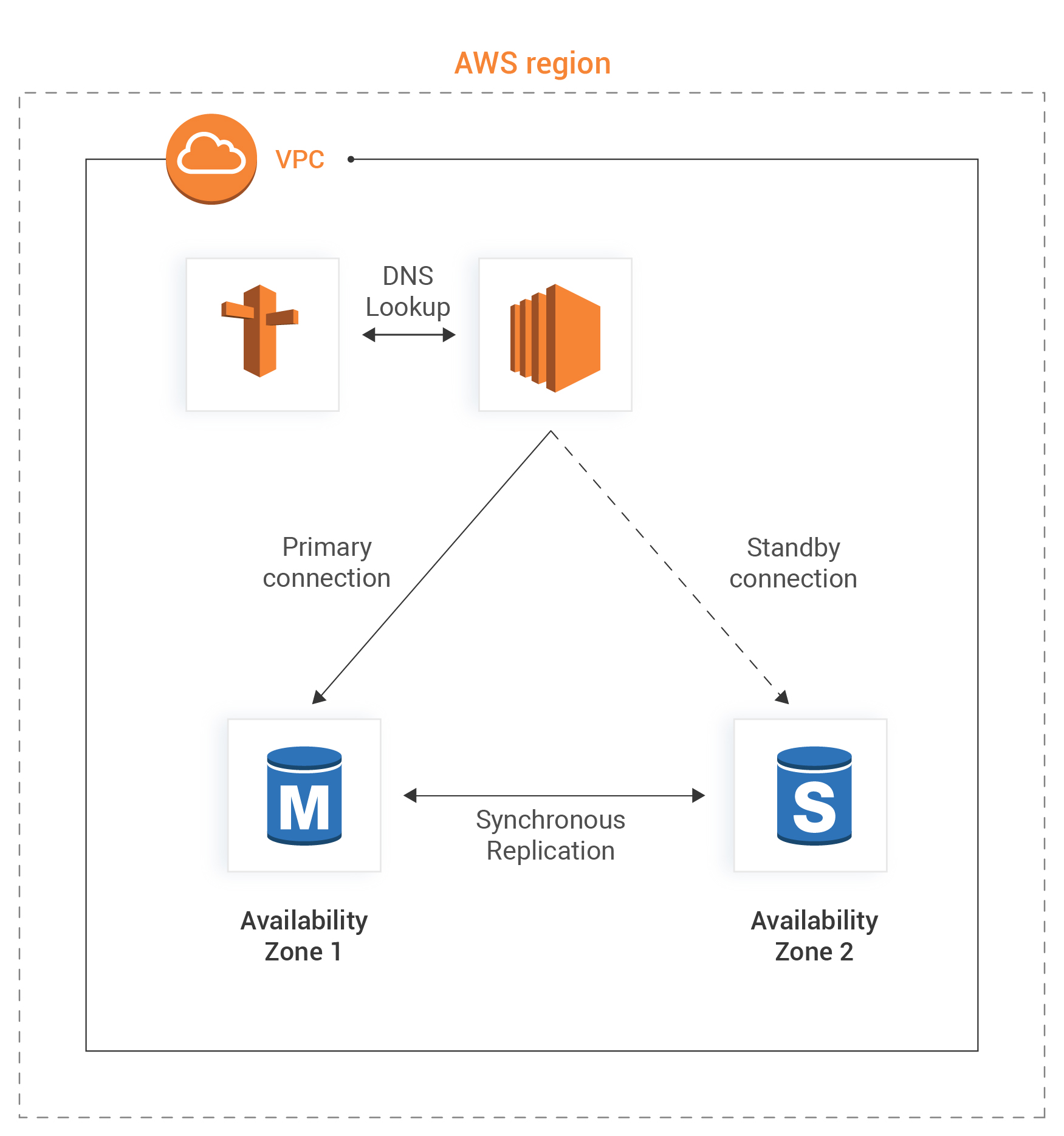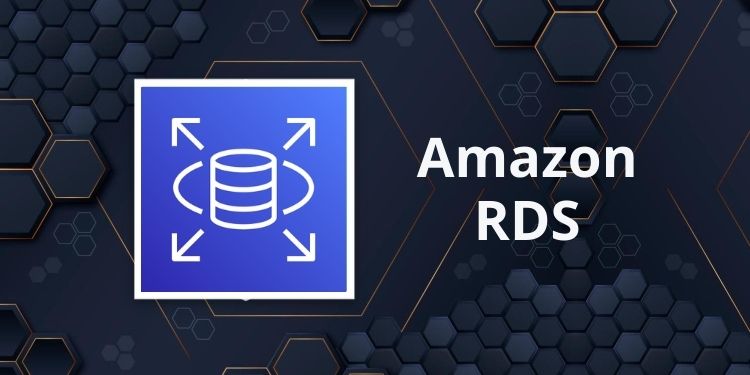What is Amazon RDS?
Amazon Relational Database Service (RDS) is a managed cloud-based relational database solution provided by Amazon Web Services (AWS). Amazon RDS simplifies the process of setting up, operating, and scaling a relational database, allowing developers and businesses to focus on their applications without worrying about time-consuming administrative tasks. These tasks include database setup, patching, and backups, all of which are automated by Amazon RDS.
As a fully managed service, Amazon RDS ensures high availability and durability, automatic failover, and robust security features. It supports six popular database engines: Amazon Aurora, PostgreSQL, MySQL, MariaDB, Oracle, and SQL Server. This support enables users to select the database engine that best fits their specific use case and technical requirements.
Key Features and Benefits of Amazon RDS
Amazon RDS offers a wide range of features and benefits that make it an attractive choice for businesses and developers looking for a managed relational database solution. Some of the primary advantages of using Amazon RDS include:
- Scalability: Amazon RDS allows users to scale their database resources up or down with ease, ensuring optimal performance and cost-effectiveness. This scalability is particularly useful for applications with fluctuating or unpredictable traffic patterns.
- Security: Amazon RDS provides robust security features, such as network isolation using Amazon Virtual Private Cloud (VPC), encryption at rest using AWS Key Management Service (KMS), and encryption in transit using SSL. These features help protect sensitive data and maintain regulatory compliance.
- Cost-effectiveness: With Amazon RDS, users only pay for the resources they consume, without the need for upfront investments or long-term commitments. Additionally, Amazon RDS offers various purchasing models, such as On-Demand, Reserved, and Spot Instances, providing flexibility in managing database costs.
- Support for popular database engines: Amazon RDS supports six widely-used database engines: Amazon Aurora, PostgreSQL, MySQL, MariaDB, Oracle, and SQL Server. This support enables users to leverage the strengths and features of their preferred database engine while benefiting from the managed services provided by Amazon RDS.
Getting Started with Amazon RDS: A ‘How to’ Guide
To begin using Amazon RDS, follow these steps to create an RDS instance:
- Select a database engine: Amazon RDS supports six popular database engines, including Amazon Aurora, PostgreSQL, MySQL, MariaDB, Oracle, and SQL Server. Choose the one that best fits your use case and technical requirements.
- Configure settings: After selecting a database engine, configure the settings for your RDS instance. This includes choosing the instance type, storage options, and network settings. You can use the AWS Management Console, AWS Command Line Interface (CLI), or AWS SDKs for ease of use and flexibility.
- Launch the instance: After configuring the settings, launch the RDS instance. Amazon RDS will automatically set up, patch, and back up your database, allowing you to focus on your application without worrying about time-consuming administrative tasks.
Once your RDS instance is up and running, you can start using it to manage your relational databases. Amazon RDS offers a wide range of features and benefits, including scalability, security, and cost-effectiveness, making it an attractive choice for businesses and developers looking for a managed relational database solution.
Best Practices for Amazon RDS
To get the most out of Amazon RDS, consider the following best practices:
- Optimize database performance: Monitor database performance and make adjustments as needed to ensure optimal performance. This includes regularly updating database statistics, using the appropriate indexes, and optimizing queries.
- Monitor resource usage: Keep an eye on resource usage, such as CPU, memory, and storage, to ensure that your RDS instance is properly sized for your workload. You can use Amazon CloudWatch to monitor resource usage and receive alerts when thresholds are exceeded.
- Implement proper backup and recovery strategies: Regularly back up your RDS instances to protect against data loss. Amazon RDS offers automated backups and database snapshots, which you can use to restore your database to a specific point in time.
- Regularly review and update database configurations: Regularly review and update your database configurations to ensure that they are aligned with your current workload and performance requirements. This includes adjusting parameters, such as memory allocation and query cache size, as needed.
By following these best practices, you can ensure that your Amazon RDS instances are running optimally, securely, and cost-effectively. This will help you get the most out of Amazon RDS and provide a better experience for your users.
Amazon RDS Use Cases and Success Stories
Amazon RDS has been successfully implemented across various industries and applications, helping businesses streamline database management, improve performance, and reduce costs. Here are some real-life use cases and success stories:
- E-commerce: Online retailers use Amazon RDS to manage their databases, ensuring high availability, scalability, and security. By using Amazon RDS, e-commerce businesses can focus on their core operations, such as marketing, sales, and customer service, without worrying about database management.
- Gaming: Game developers use Amazon RDS to manage their databases, ensuring low latency and high performance. By using Amazon RDS, game developers can focus on creating engaging games, without worrying about database management.
- Financial services: Financial institutions use Amazon RDS to manage their databases, ensuring high security, compliance, and scalability. By using Amazon RDS, financial institutions can focus on their core operations, such as data analysis and risk management, without worrying about database management.
- Healthcare: Healthcare providers use Amazon RDS to manage their databases, ensuring high availability, scalability, and security. By using Amazon RDS, healthcare providers can focus on their core operations, such as patient care and data analysis, without worrying about database management.
These are just a few examples of how Amazon RDS has been successfully implemented across various industries and applications. By using Amazon RDS, businesses can streamline database management, improve performance, and reduce costs, allowing them to focus on their core operations and provide a better experience for their users.
Comparing Amazon RDS with Other Database Services
Amazon RDS is a powerful managed relational database service, but it’s not the only option available. Here’s a comparison of Amazon RDS with other popular database services, including Amazon Aurora, Amazon DynamoDB, and self-managed databases, to help you decide which option is best for your needs:
- Amazon RDS vs. Amazon Aurora: Amazon Aurora is a high-performance, MySQL-compatible database engine that is fully managed by Amazon RDS. It offers improved performance, scalability, and security compared to standard MySQL databases. If you need a high-performance MySQL-compatible database, Amazon Aurora is a great option. However, if you need support for other database engines, such as PostgreSQL or Oracle, Amazon RDS is a better choice.
- Amazon RDS vs. Amazon DynamoDB: Amazon DynamoDB is a NoSQL database service that is fully managed by AWS. It offers high performance, scalability, and flexibility, making it a great option for applications that require fast and flexible data access. However, if you need support for relational databases, such as MySQL or Oracle, Amazon RDS is a better choice.
- Amazon RDS vs. Self-managed databases: Self-managed databases offer more control and flexibility compared to managed database services like Amazon RDS. However, they also require more time and resources to manage, including database setup, patching, and backups. If you need more control and flexibility, and have the resources to manage a self-managed database, it may be a good option. However, if you want to save time and resources, and prefer a more hands-off approach, Amazon RDS is a better choice.
By comparing Amazon RDS with other database services, you can make an informed decision about which option is best for your needs. Each option has its own pros and cons, and the right choice depends on your specific requirements, resources, and preferences.
Amazon RDS Pricing and Cost Optimization Strategies
Amazon RDS pricing is based on a pay-as-you-go model, which means you only pay for the resources you use. The cost of Amazon RDS depends on several factors, including the database engine, instance type, storage, and backup options. Here are some cost optimization strategies to help you get the most out of Amazon RDS:
- Select the right instance type: Amazon RDS offers a variety of instance types with different performance characteristics and costs. Choose the instance type that best fits your workload and budget. For example, if you have a small workload, a cheaper instance type with lower performance may be sufficient. However, if you have a large workload, a more expensive instance type with higher performance may be necessary.
- Use reserved instances: Reserved instances offer significant discounts compared to on-demand instances. If you have a predictable and steady workload, reserved instances can help you save up to 75% on your Amazon RDS costs. There are three types of reserved instances: standard, convertible, and scheduled. Choose the type that best fits your needs and budget.
- Utilize Amazon RDS Reserved DB Instances: Amazon RDS Reserved DB Instances offer significant discounts compared to on-demand DB instances. If you have a predictable and steady workload, Reserved DB Instances can help you save up to 64% on your Amazon RDS costs. There are three types of Reserved DB Instances: No Upfront, Partial Upfront, and All Upfront. Choose the type that best fits your needs and budget.
- Monitor resource usage: Monitor your Amazon RDS resource usage regularly to identify any inefficiencies or areas for optimization. Use Amazon CloudWatch to monitor metrics such as CPU utilization, memory usage, and network traffic. Adjust your database configurations and resource allocations as needed to optimize performance and reduce costs.
By following these cost optimization strategies, you can reduce your Amazon RDS costs and get the most out of your investment. Remember to regularly review and update your database configurations and resource allocations to ensure they align with your workload and budget.
Securing Amazon RDS: Tips and Recommendations
Security is a top priority for businesses using cloud-based relational database services like Amazon RDS. To ensure the security of your Amazon RDS instances, follow these tips and recommendations:
- Implement encryption: Amazon RDS supports encryption at rest and in transit. Use encryption at rest to protect your data from unauthorized access, and use encryption in transit to secure your data as it moves between your application and your database. Enable encryption when creating your Amazon RDS instance, or enable it later by modifying your instance settings.
- Manage access controls: Manage access to your Amazon RDS instances by implementing access controls. Use AWS Identity and Access Management (IAM) to manage access to the AWS Management Console, AWS CLI, and AWS SDKs. Use Amazon RDS security groups to control network access to your instances. Use database authentication and authorization mechanisms, such as SQL Server Authentication and PostgreSQL Role-Based Access Control, to manage access to your databases and tables.
- Monitor for suspicious activities: Monitor your Amazon RDS instances for suspicious activities, such as failed login attempts, unusual query patterns, and unauthorized data access. Use Amazon CloudWatch to monitor metrics such as CPU utilization, memory usage, and network traffic. Use AWS Trusted Advisor to check for security best practices and vulnerabilities. Use Amazon RDS audit logging to track database activities and identify potential security threats.
- Regularly review and update database configurations: Regularly review and update your database configurations to ensure they align with your security policies and best practices. Use AWS Config to record configuration changes and audit your resources. Use AWS Systems Manager Parameter Store to securely store and manage your configuration data.
By following these tips and recommendations, you can secure your Amazon RDS instances and protect your data from unauthorized access and threats. Remember to regularly review and update your security policies and best practices to ensure they are up-to-date and effective.





